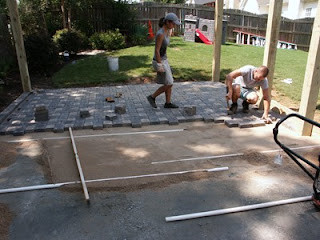 |
| Planting a large Willow Oak |
First I will share with you what we have found to be the best way to install your new plantings.
- Measure the size of the root ball of your tree or shrub. You want to know the height and the diameter.
- Dig your hole so that 2" of the root ball will be above the preexisting ground level if it is a shrub. Most trees should be 4" above ground level, Dogwood trees should be 6" above. The number one reason we see plants not thrive is that they were planted too low.
- The diameter of the hole you dig should be about 50% greater than that of the root ball.
- As you are removing soil from the hole, chop it up with your shovel so that there are no large chunks of dirt.
- Install plant, use fill dirt to fill bottom 1/3 of hole around plant and make sure everything is level, plum and facing the way you want it to face.
- Mix in mushroom compost with the remaining soil. We use one 40 lb bag of compost for three 3 gallon plants. 2 entire bags for a larger tree. We have found that mushroom compost is vastly superior to peat moss and other things you can buy as a soil additive.
- Add some granular 10-10-10 fertilizer. You can use many different types of fertilizer but 10-10-10 works and is cheap. About 1/2 a handful for shrubs, two hand fulls for a big tree.
- Now fill the remaining part of the hole with the soil/compost/fertilizer mix. Make sure you do not go above the top of the root ball.
- Rake the area smooth and install mulch or pine needles.
New plantings need proper watering above anything else. The weather and rainfall you receive will determine exactly how much. We recommend watering very thoroughly the day you plant. In general you want to continue to water thoroughly but not frequently. It is hard to be specific because you will plant at different times of the year and experience different temperatures and humidity's. Remember that plants need water AND oxygen to survive. You can't let them dry out too much or they die from lack of water. You can't keep the soil too wet or they don't get the oxygen they need.
If you planted in the fall, we like another dose of 10-10-10 granular fertilizer in mid spring. We also recommend that you pay the most attention to watering frequently the first summer. If your plants survive their first summer in your landscape.... they generally do well after that without so much intensive care.
A great thing we have found in addition to the above is to add a "root stimulator" to your watering's. This comes in a liquid form. Something like this will work well. Apply this every 10 days for 3-5 applications.
Make sure you keep your plantings properly mulched. This means enough to keep the soil covered with at least 2" of mulch or pine needles.... but not so much that you cover the base(trunk) of the plant.
Good luck!
Rich























































